seats CHEVROLET CORVETTE 1994 4.G Owners Manual
[x] Cancel search | Manufacturer: CHEVROLET, Model Year: 1994, Model line: CORVETTE, Model: CHEVROLET CORVETTE 1994 4.GPages: 274, PDF Size: 15.61 MB
Page 2 of 274
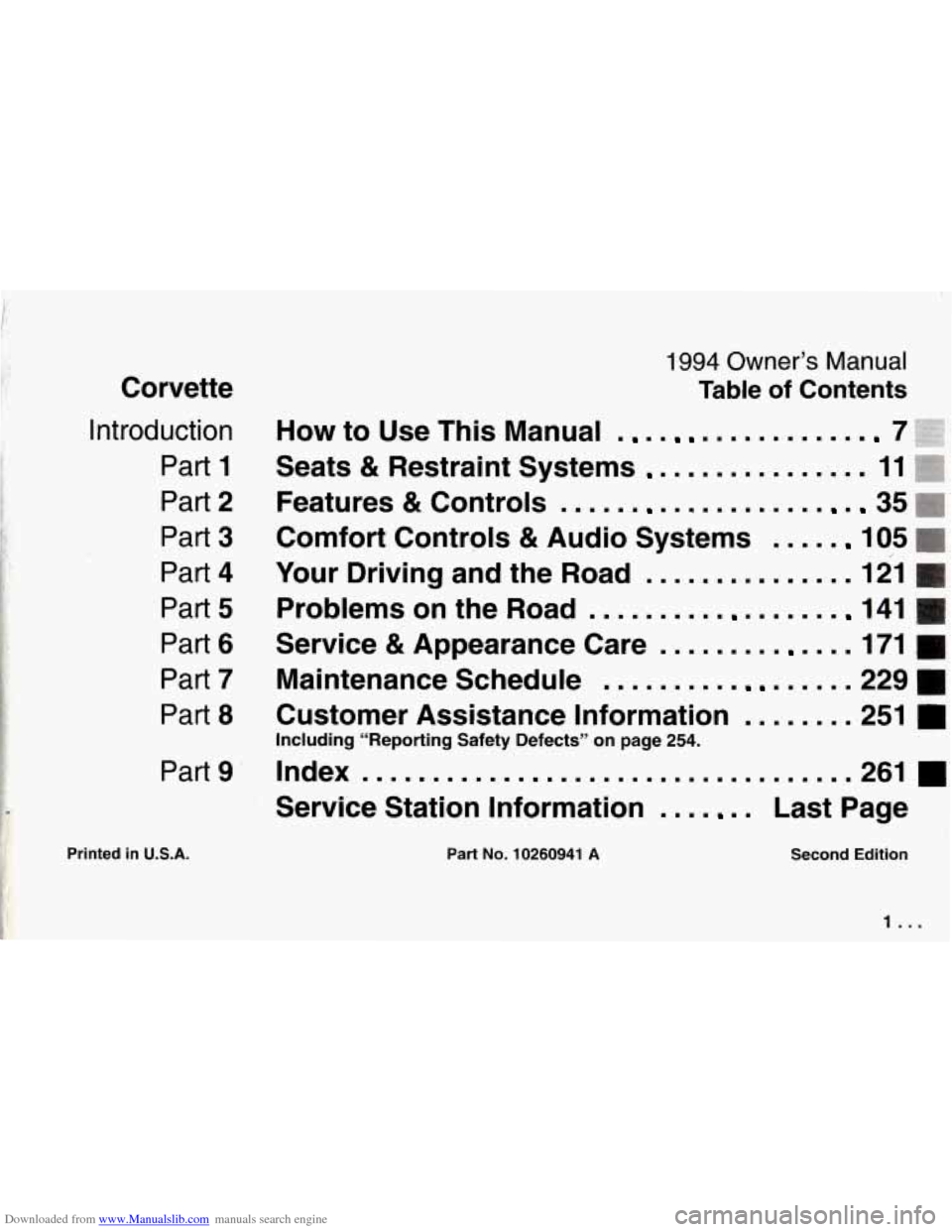
Downloaded from www.Manualslib.com manuals search engine Corvette
Introduction
Part 1
Part 2
Part 3
Part 4
Part 5
Part 6
Part 7
Part 8
Part 9 '
1994 Owner's Manual
Table of Contents
How to Use This Manual 7 :!&$@
Seats & Restraint Systems 11
Features & Controls = = 35
Comfort Controls & Audio Systems 105
Your Driving and the Road = 121
Problems on the Road 141
Service & Appearance Care 171
Maintenance Schedule 229
Customer Assistance Information 251 m
Index .................... ............... 261
Service Station Information a Last Page
g%y,$pL%>
*"xr7*i.. * .?*2<;.piV$;'
Including "Reporting Safety Defects" on page 254.
Printed in U.S.A. Part No. 10260941 A Second Edition
1 ..
Page 8 of 274
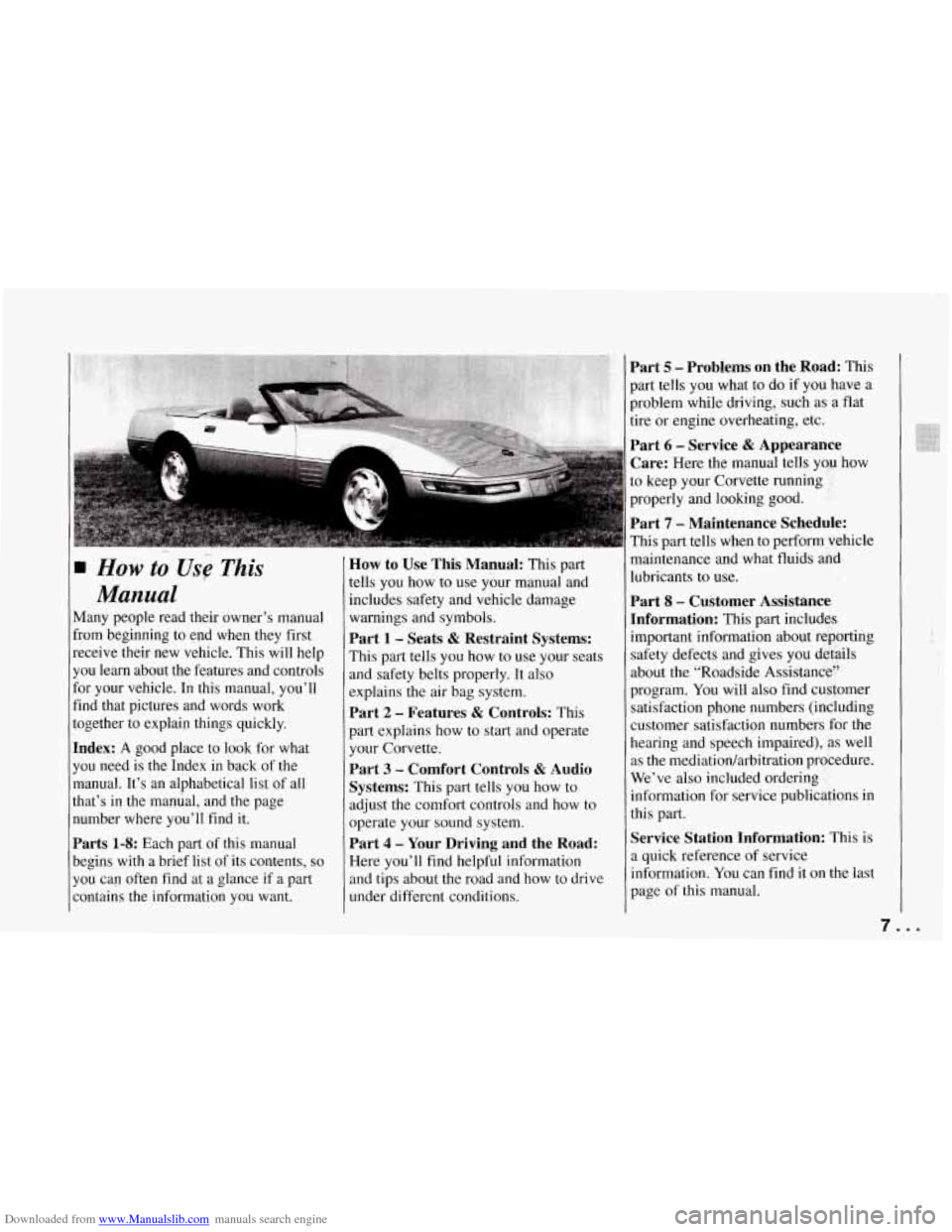
Downloaded from www.Manualslib.com manuals search engine How to Us; This
Manual
5.-
Many people read their owner’s manual
from beginning to end when they first
receive their new vehicle. This will help
you learn about the features and controls
for your vehicle.
In this manual, you’ll
find that pictures and words work
together to explain things quickly.
Index: A good place to look for what
you need is the In-dex in back of the
manual. It’s an alphabetical list of all
that’s iq the manual, and the page
number where you’ll find it.
Parts 1-8: Each part of this manual
begins with a brief list of its contents,
so
you cap often find at a glance if a part
Eontains the information you want.
How to Use This Manual: This part
tells you how to use your manual and
includes safety and vehicle damage
warnings and symbols.
Part 1 - Seats & Restraint Systems:
This part tells you how to use your seats
and safety belts properly. It also
explains the
air bag system.
Part 2 - Features & Controls: This
part explains how to start and operate
your Corvette.
Part 3 - Comfort Controls & Audio
Systems:
This ,part tells you how to
adjust the comfort controls and
how to
operate your sound system.
Part 4 - Your Driving and the Road:
Here you’ll find helpful information
and tips about the road and how to drive
under different conditions.
Part 5 - Problems on the Road: This
>art tells you what to do if you have a
Jroblem while driving, such as a flat
:ire or engine overheating, etc.
Part 6 - Service & Appearance
Care:
Here the manual tells yqap how
:o keep your Corvette running ’’:;’.
properly and looking good. ’,:.
Part 7 - Maintenance Schedule:
This part tells when to perfom,,vehicle
maintenance and what fluids
a&l
lubricants to use.
Part 8 - Customer Assistanc?
~nformation:
This part includ&
important information about rdiorting
safety defects and gives you &$$ls
about the “Roadside Assistancq?
program. You will also find cG$@mer
satisfaction phone numbers (ir&luding
customer satisfaction numbers .for the
hearing and speech impaired),
&s well
as the mediationhrbitration prokedure.
We’ve also included ordering
information for service publicagions in
this part.
Service Station Information: This is
a quick reference of service
information. You can find it
on the last
page of this manual.
..
I ‘I ,
7 I ...
Page 12 of 274
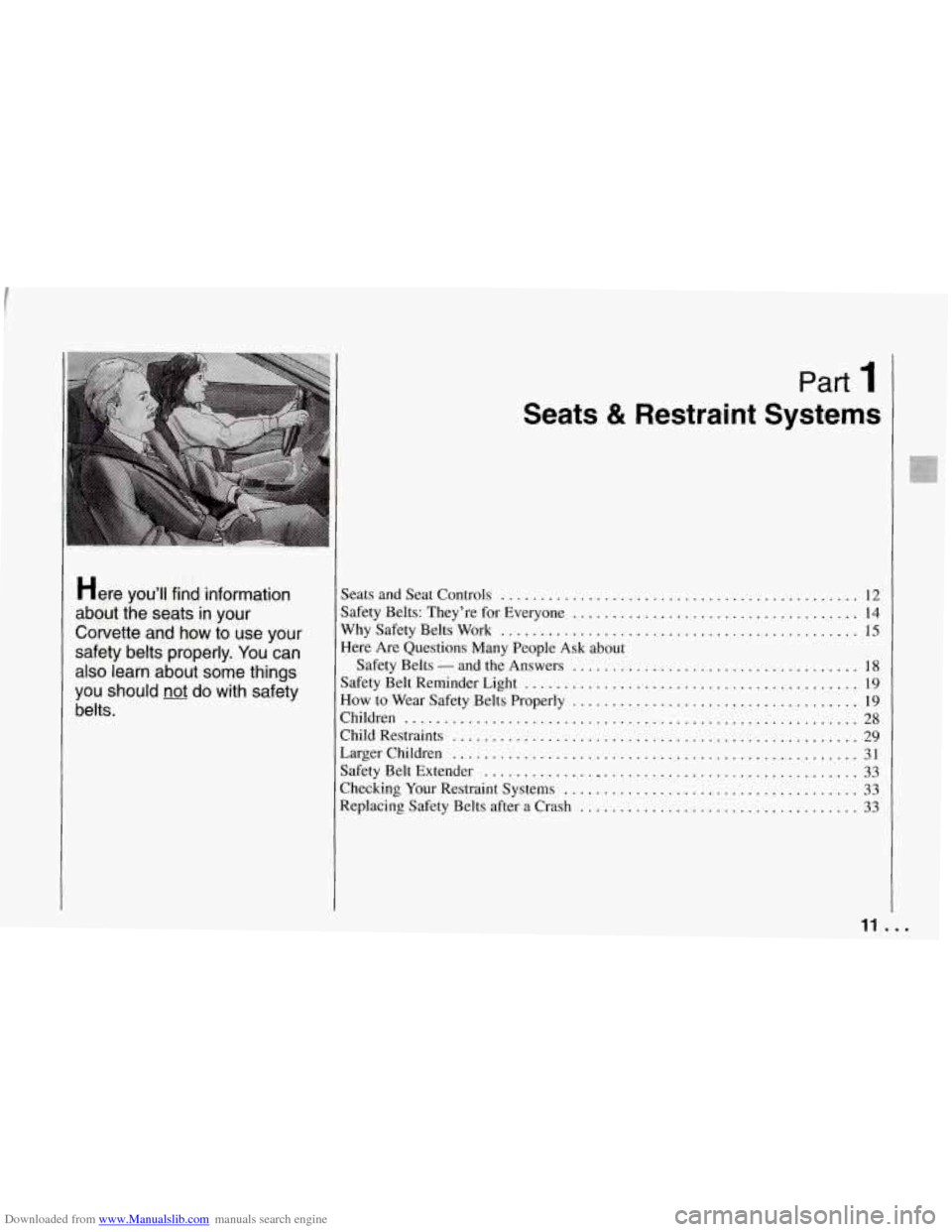
Downloaded from www.Manualslib.com manuals search engine Here you’ll find information
about the seats in your
Corvette and how to use your
safety belts properly
. You can
also learn about some things
you should
not do with safety
belts
.
Part 1
Seats 81 Restraint Systems
............................................. seats and Seat Controls 12
safety Belts: They’re for Everyone .................................... 14
Nhy Safety Belts Work
............................................. 15
Safety Belts
. and the Answers ........ ..................... 18
Safety Belt Reminder Light
......... .......................... 19
2hildren ...................... ............................ 28
Safety Belt Extender
.............. ................................ 33
Zhecking Your Restraint Systems ..................................... 33
Replacing Safety Belts after a Crash ................................... 33
lere Are Questions Many People Ask about
3ow to Wear Safety Belts Properly
... ............................ 19
Ihild Restraints 29
LargerChildren
................................................... 31
...................................................
11 ..
Page 13 of 274
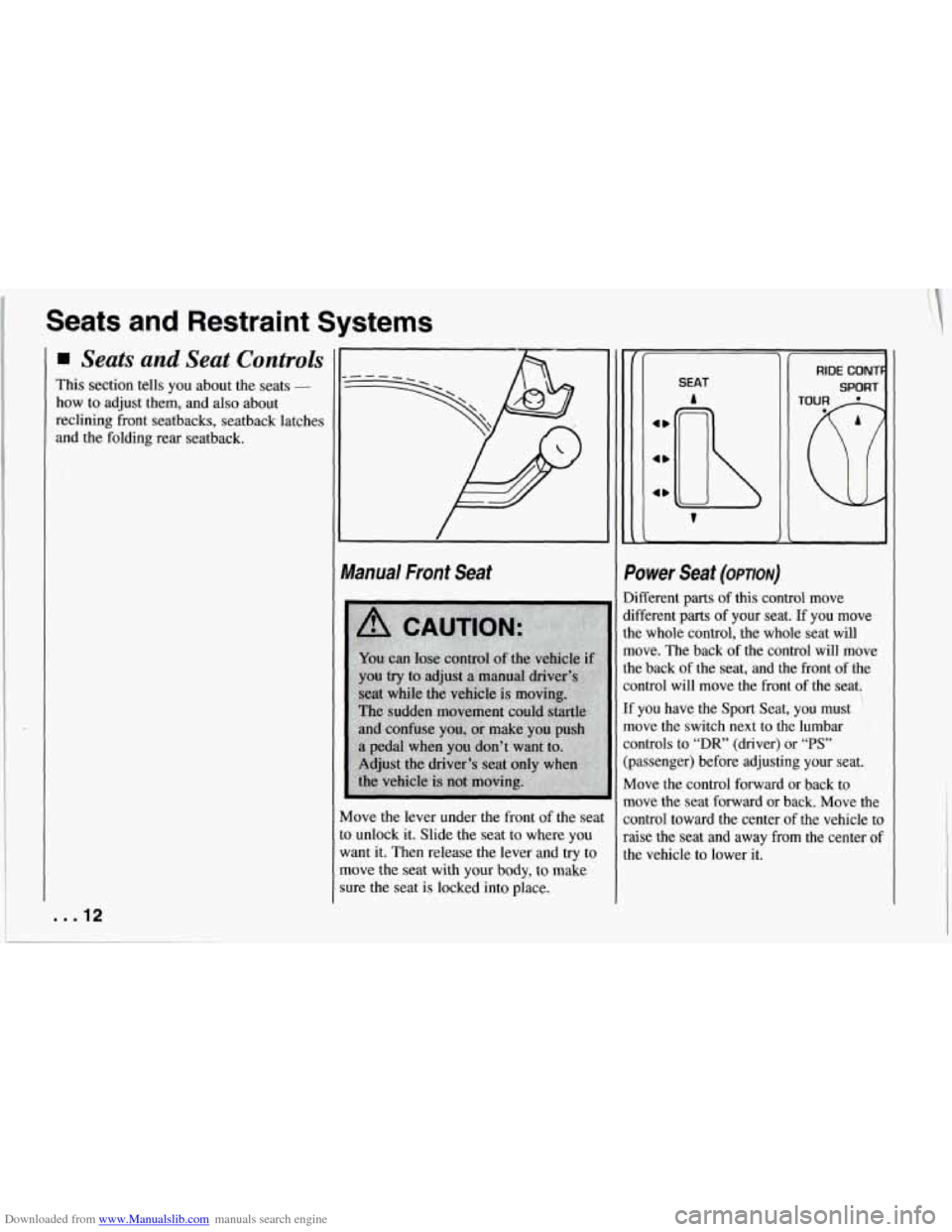
Downloaded from www.Manualslib.com manuals search engine Seats and Restraint Systems
Seats and Seat Controls
This section tells you about the seats -
how to adjust them, and also about
reclining front seatbacks, seatback latches
and the folding
rear seatback.
k
&
Mc
to
WS
mc
SUI
anual Front Seat
4B
4b
4b
SEAT
A
RIDE CONTF
SPORT
Dwer Seat (OPTION)
fferent parts of this control move
Yerent
parts of your seat. If you move
5 whole control, the whole seat will
we. The back of the control will move
: back of the seat, and the front of the
ntrol will move the front of the seat.
you have the
Sport Seat, you must
lve the switch next to the lumbar
ntrols to
“DR’ (driver) or “PS”
assenger) before adjusting your seat.
ove the control forward or back to
we the seat forward or back. Move the
ntrol toward the center of the vehicle to
Ise the seat and away from the center
of
: vehicle to lower it.
L
Page 15 of 274
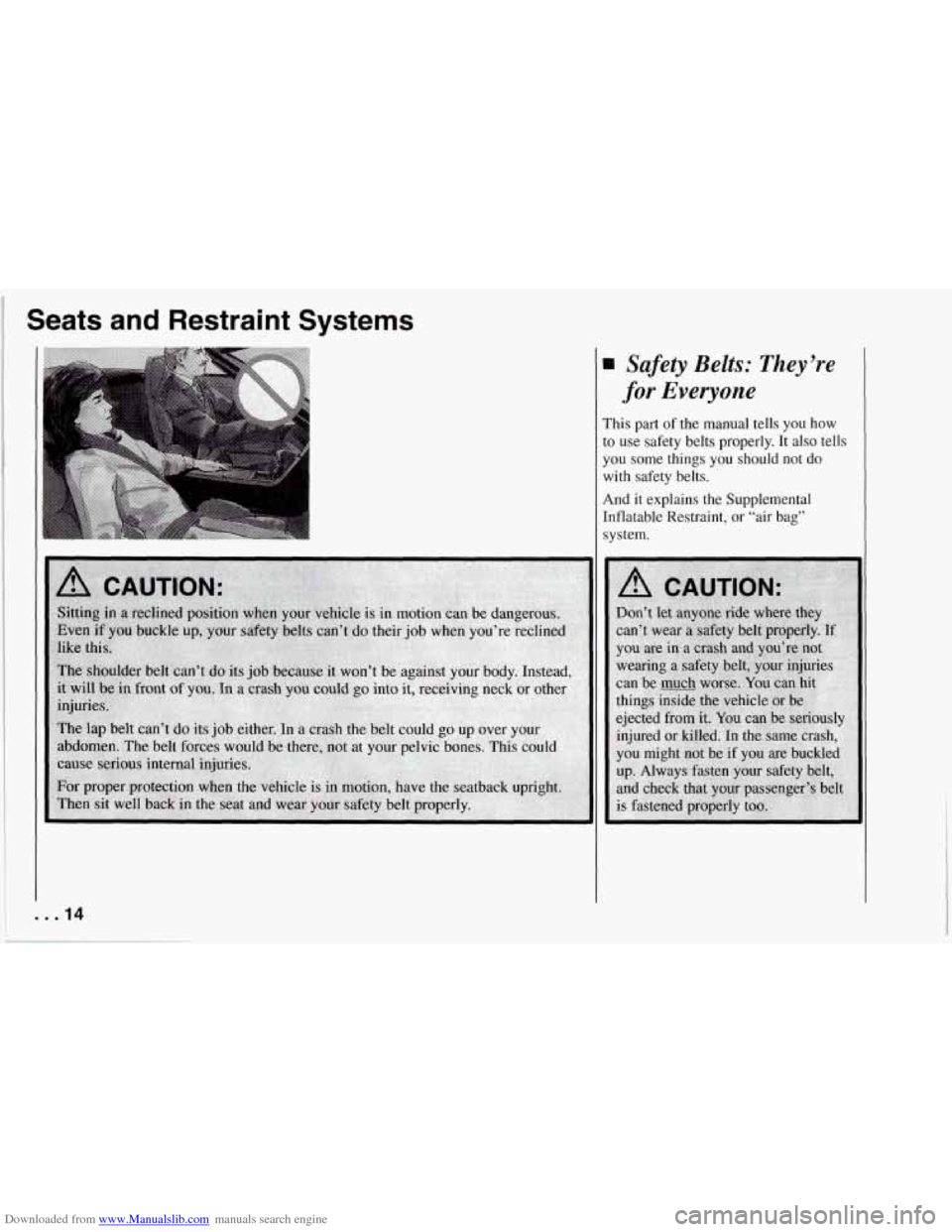
Downloaded from www.Manualslib.com manuals search engine Seats and Restraint Systems
Safety Belts: They’re
for Everyone
This part of the manual tells you how
to use safety belts properly. It
also tells
you some things you
should not do
with safety belts.
And it explains the Supplemental Inflatable Restraint, or “air bag”
system.
. . .I4
Page 17 of 274
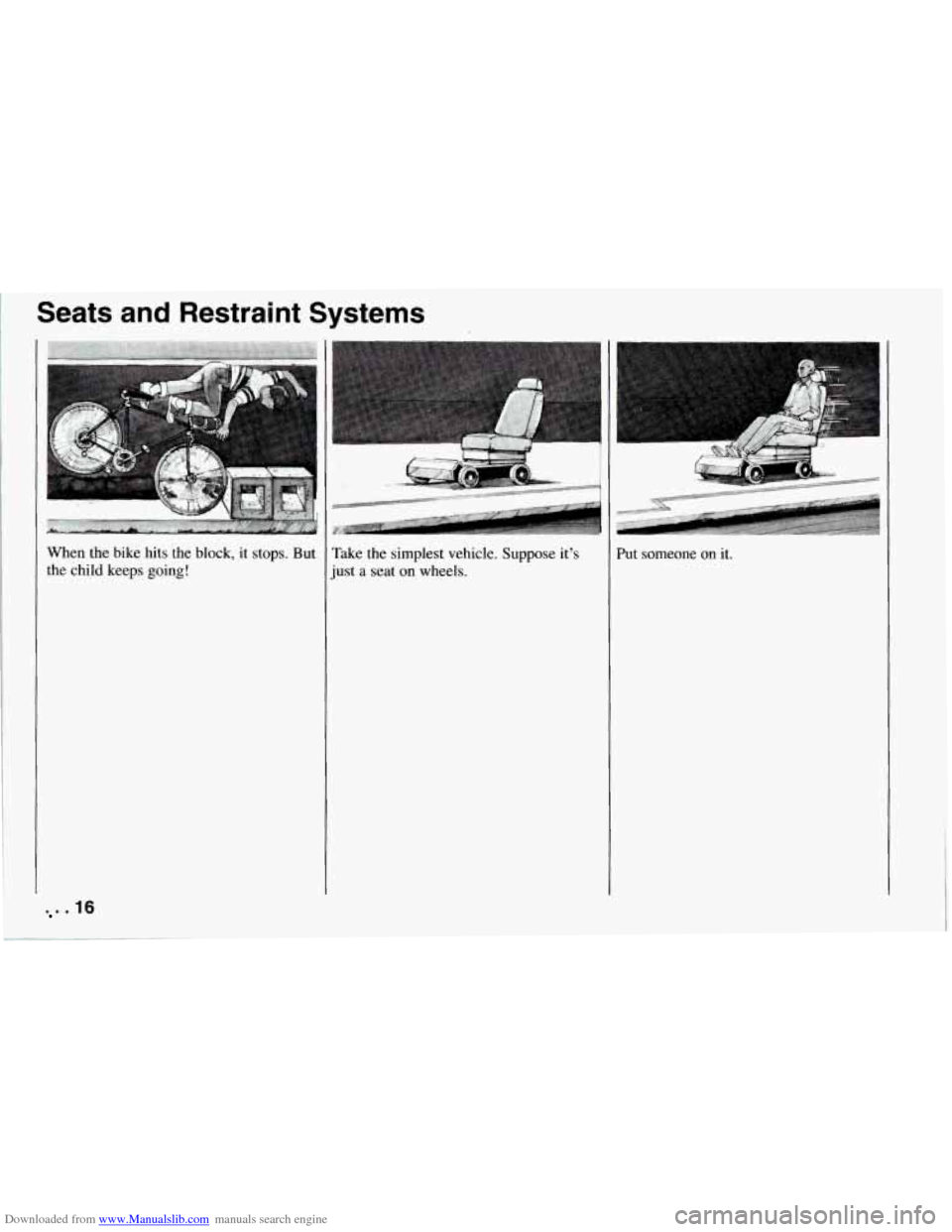
Downloaded from www.Manualslib.com manuals search engine Seats and Restraint Systems
When the bike hits the block, it stops. But
the child keeps going!
. .I6
Take the simplest vehicle. Suppose it's
just a seat on wheels. Put someone on it.
Page 19 of 274
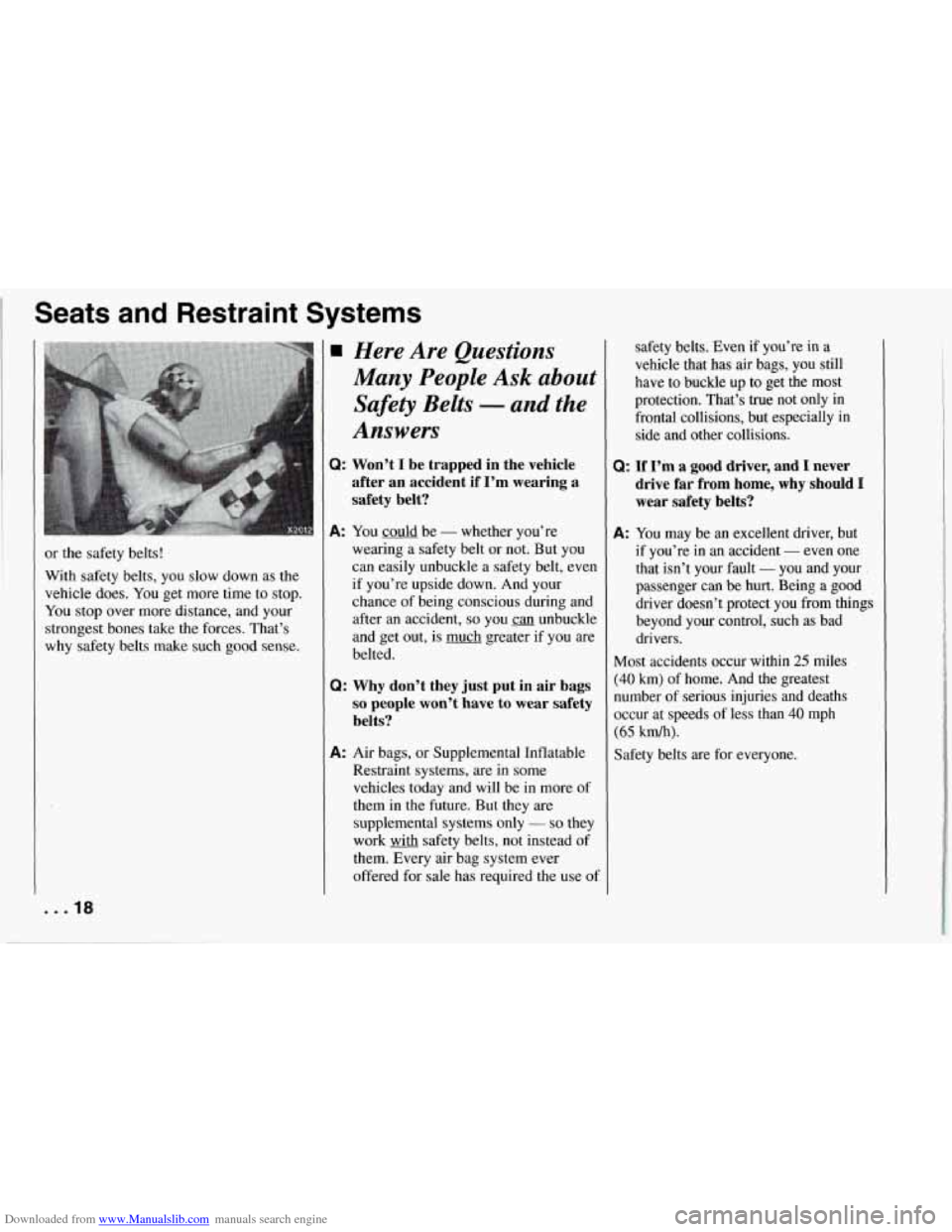
Downloaded from www.Manualslib.com manuals search engine Seats and Restraint Systems
or the safety belts!
With safety belts, you slow down as the
vehicle does.
You get more time to stop.
You stop over more distance, and your
strongest bones take the forces. That’s
why safety belts make such good sense.
. . .I%
Here Are Questions
Many People Ask about
Safety Belts
- and the
Answers
Q: Won’t I be trapped in the vehicle
after an accident if I’m wearing
a
safety belt?
A: You could be - whether you’re
wearing a safety belt or not. But you
can easily unbuckle a safety belt, even
if you’re upside down. And your
chance of being conscious during and
after an accident,
so you can unbuckle
and get out,
is much greater if you are
belted.
Q: Why don’t they just put in air bags
so people won’t have to wear safety
belts?
A: Air bags, or Supplemental Inflatable
Restraint systems, are in some
vehicles today and will be
in more of
them in
the future. But they are
supplemental systems only
- so they
work safety belts, not instead of
them. Every air bag system ever
offered for sale has required the use of safety belts. Even
if you’re in a
vehicle that has
air bags, you still
have to buckle up
to get the most
protection. That’s true not only in frontal collisions, but especially in
side and other collisions.
Q: If I’m a good driver, and I never
drive far from home, why should I
wear safety belts?
A: You may be an excellent driver, but
if you’re
in an accident - even one
that isn’t your fault
- you and your .
passenger can be hurt. Being a good driver doesn’t protect you from things
beyond your control, such as bad
drivers.
Most accidents occur within
25 miles
(40 km) of home. And the greatest
number of serious injuries and deaths
occur at speeds of less than
40 mph
(65 km/h).
Safety belts are for everyone.
Page 21 of 274
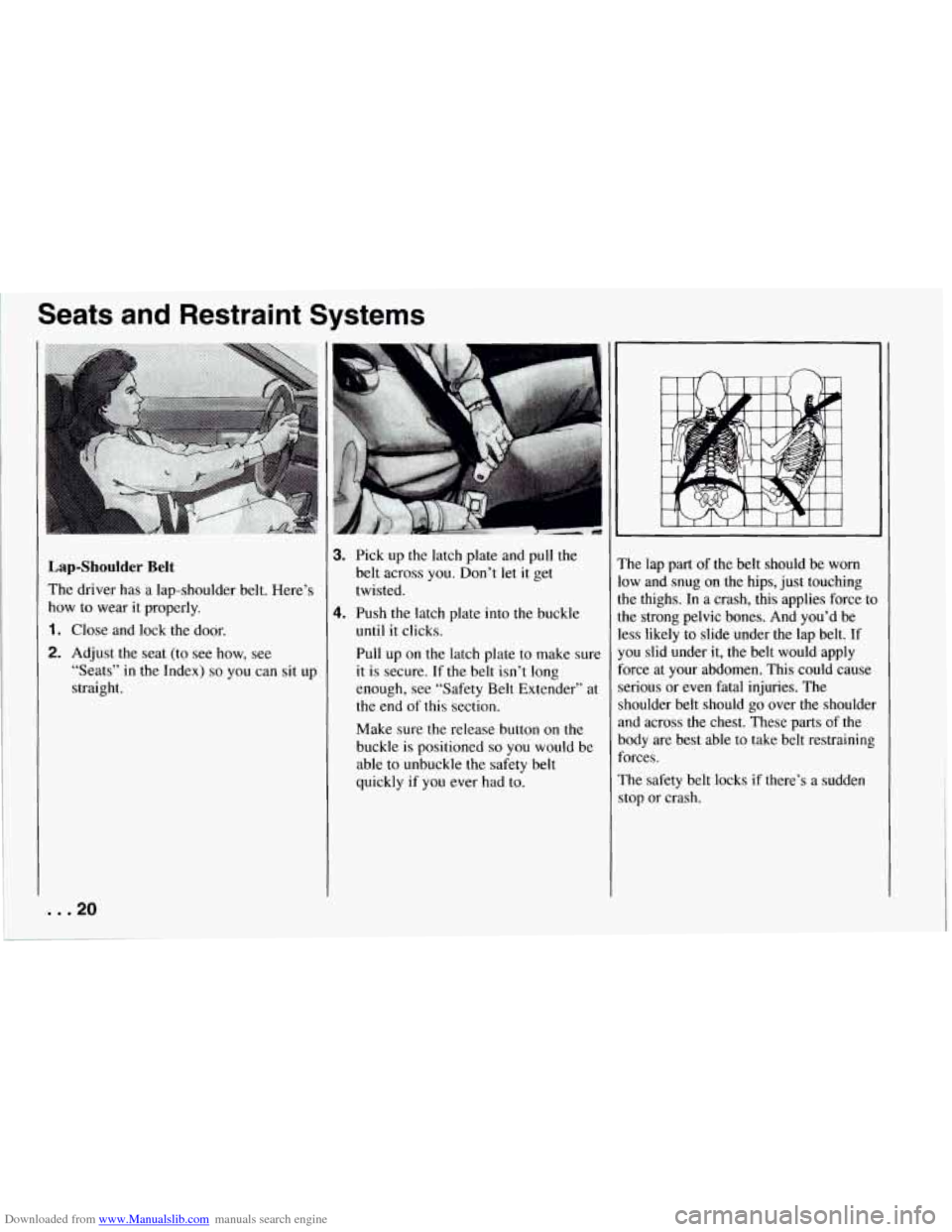
Downloaded from www.Manualslib.com manuals search engine Seats and Restraint Systems
Lap-Shoulder Belt
The driver has a lap-shoulder belt. Here’s
how to wear it properly.
1. Close and lock the door.
2. Adjust the seat (to see how, see
“Seats” in
the Index) so you can sit up
straight.
... 20
3. Pick up the latch plate and pull the
belt across you. Don’t let it get
twisted.
4. Push the latch plate into the buckle
until it clicks.
Pull up on the latch plate to make sure
it is secure. If the belt isn’t long
enough, see “Safety Belt Extender” at
the end of this section.
Make sure the release button on the
buckle is positioned
so you would be
able to unbuckle the safety belt
quickly if you ever had to. ’he
lap part of
the belt should be worn
3w and snug on the hips, just touching
he thighs. In a crash, this applies force to
he strong pelvic bones. And you’d be
ess likely to slide under the lap belt. If
[ou slid under it, the belt would apply
orce at your abdomen. This could cause
;erious or
even fatal injuries. The
‘houlder belt should go over the shoulder
md across the chest. These parts of the
pody are best able to take belt restraining
orces.
The safety belt locks if there’s a sudden
top or crash.
Page 23 of 274
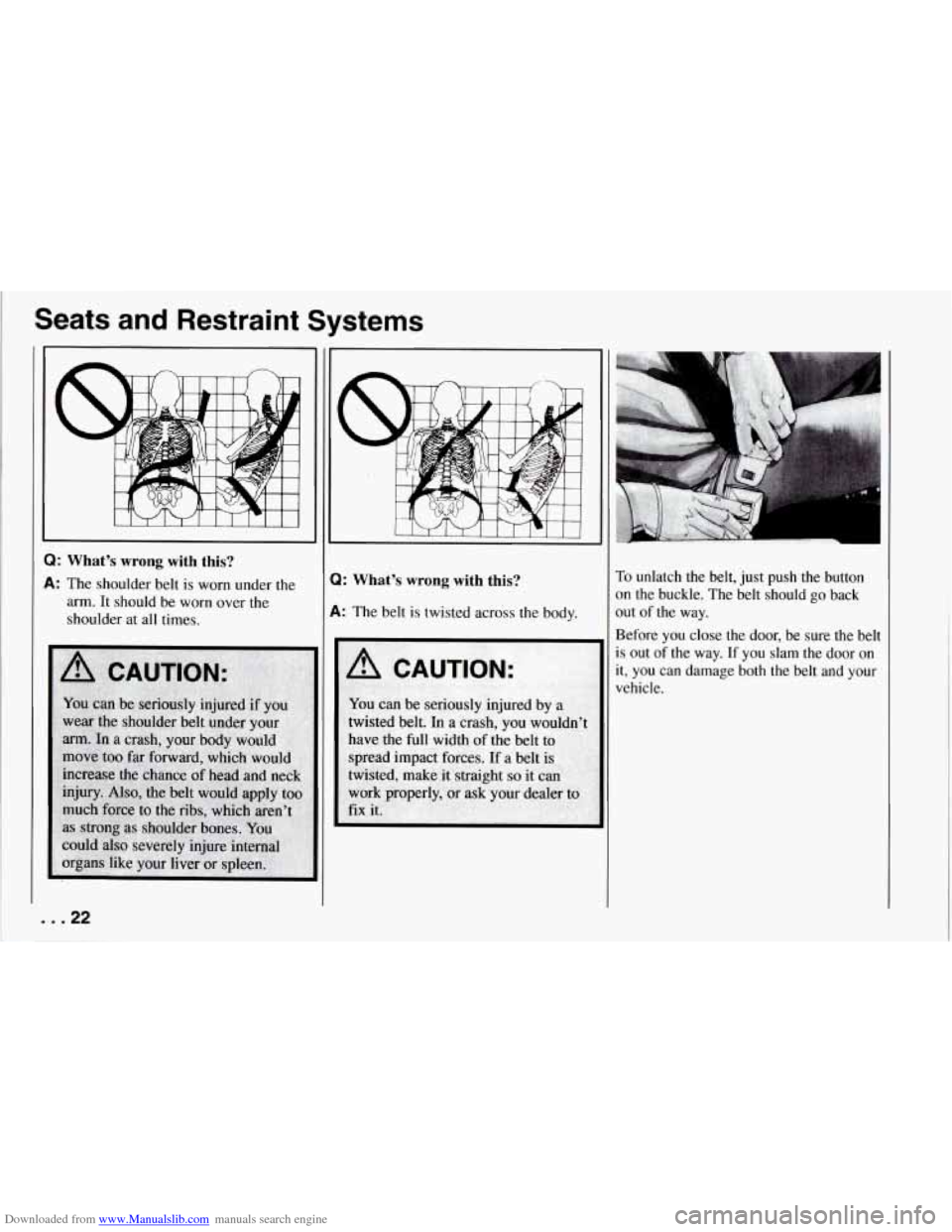
Downloaded from www.Manualslib.com manuals search engine Seats and Restraint Systems
t":
Q: What's wrong with this?
A: The shoulder belt is worn under the
arm. It should be
worn over the
shoulder at all times.
. . .22
Q: What's wrong with this?
A: The belt is twisted across the body. To unlatch
the belt, just push the button
on the buckle. The belt should go back
out
of the way.
Before you close the door, be sure the belt
is out of the way. If you slam the door on
it,
you can damage both the belt and your
vehicle.
Page 25 of 274
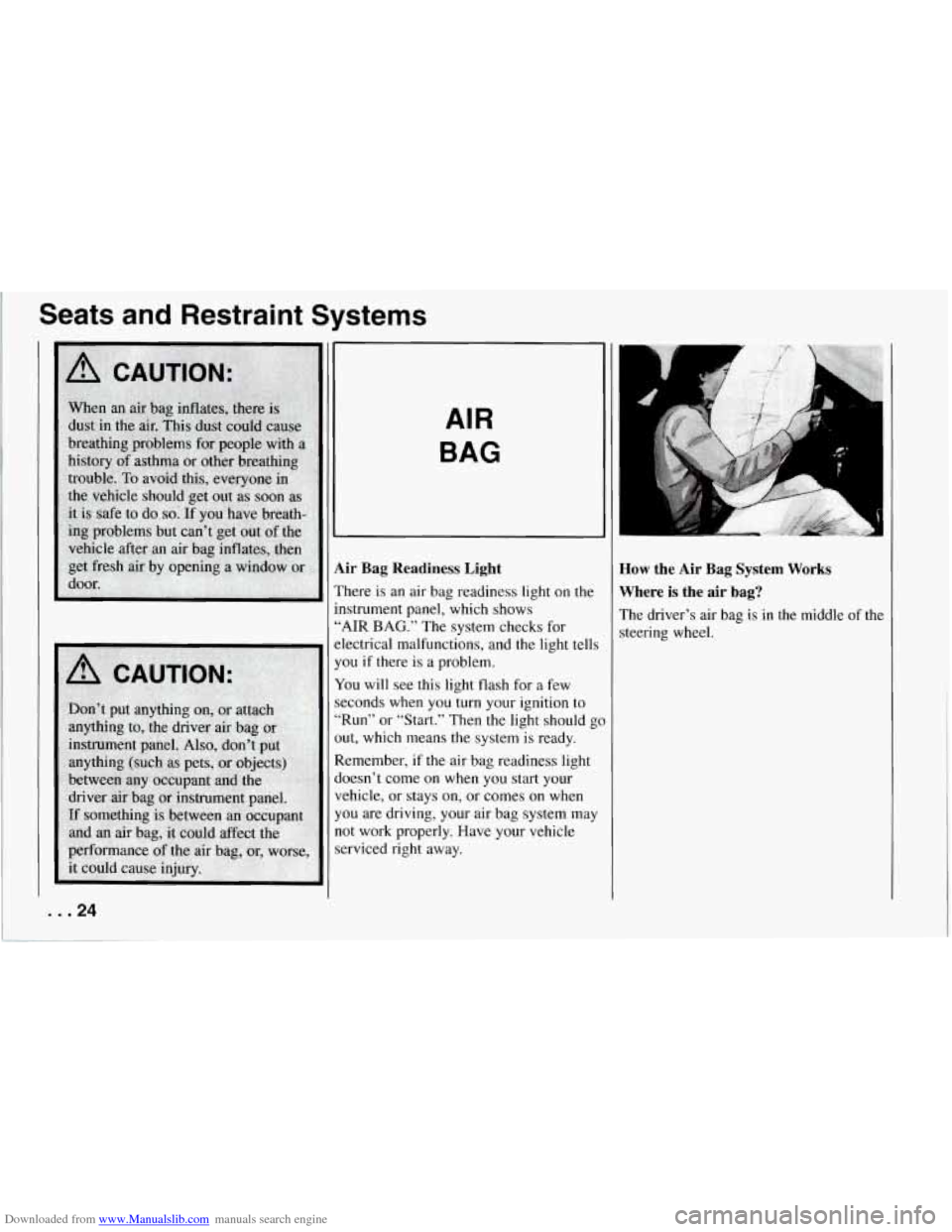
Downloaded from www.Manualslib.com manuals search engine Seats and Restraint Systems
... 24
AIR
BAG
Air Bag Readiness Light
There is an air bag readiness light on the
instrument panel, which shows
“AIR BAG.” The system checks for
electrical malfunctions, and the light tell!
you if there is a problem.
You
will see this light flash for a few
seconds when you turn your ignition to
“Run” or “Start.” Then the light should
2
out, which means the system is ready.
Remember,
if the air bag readiness light
doesn’t come
on when you start your
vehicle, or stays on, or comes
on when
you are driving, your air bag system mal
not work properly. Have your vehicle
serviced right away.
Iow the Air Bag System Works
Yhere is the air bag?
.’he driver’s air bag is in the middle of the
;teering wheel.